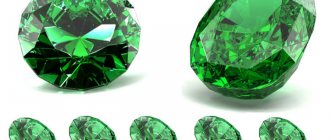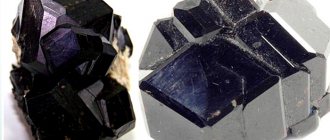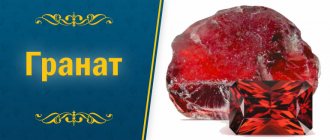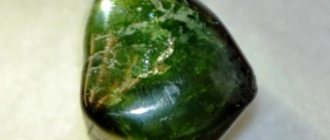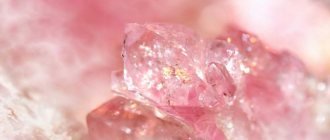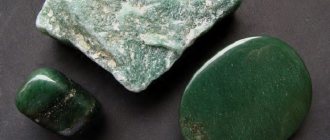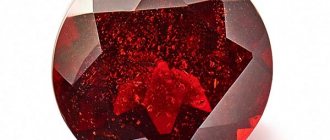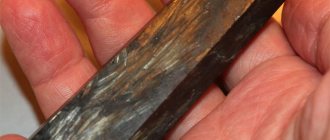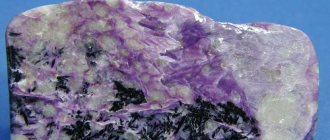Green garnet has always attracted lovers of precious stones. Rare and mysterious, it resembles an emerald with all its qualities. The literal translation of his name is “He who is like a diamond.” It is so rare in nature that not everyone can afford such decoration. It has several names: “tausonite”, “Bobrovsky garnet”, “marvelite”, “Ural emerald”. It is noted that this is the only stone that can shimmer like a rainbow.
History and origin
Since the time of the Scythians, jewelry has been made using garnet. The stone received its name for its external color resemblance to the grains of pomegranate fruit.
Green pomegranate
The mineral gained its fame and recognition from the ancient Persians. In those days it was considered the “stone of kings.” Jewelers of antiquity selected the largest nuggets and engraved images of their rulers on them. In ancient Rus', pomegranate was also known and widely distributed under the names “becheta” and “venisa”.
A favorite of jewelers, it was incredibly prized for jewelry making and by the first half of the 20th century was worth much more than the equally popular alexandrite.
Garnet stone belongs to the class of silicates, which include several varieties that differ in color. In nature, these minerals are found in almost all shades except blue. The unusual green mineral is extremely rare to find, which makes it much more desirable and expensive. Subspecies of garnet include stones such as pyrope, almandine, and grossular.
Greek bracelets with uvarovite
Application
Green pomegranate has become famous since the end of the nineteenth century. It was during this time that it was widely used in a wide variety of jewelry. And these grenades reached their peak of popularity in the age of romanticism. It was then that they began to be cut in two ways - diamond and flat step.
Jewelry made from green garnet began to quickly gain popularity both among the Russian nobility and among foreigners. These stones began to be used in the manufacture of rings, earrings, necklaces, pendants and other jewelry.
Physicochemical characteristics
“Royal Stone” has a list of physical and chemical properties that characterize it. Among the main ones, one can highlight its incredible strength. If you run it across the glass, it will leave a scratch, but the stone will not be damaged.
Uvarovite is a mineral consisting of small grains. In nature, the surface of this stone resembles sandpaper.
| Formula | Ca3Cr2[SiO4]3 (silicates) |
| Color | Green in various shades |
| Shine | Glass |
| Transparency | Translucent |
| Hardness | 7.5 — 8 |
| Cleavage | Very imperfect |
| Kink | Conchoidal, uneven |
| Density | 3.40—3.80 g/cm3 |
Description
Uvarovite is a type of garnet group, which is colored in a beautiful emerald shade. It received its name in honor of the famous Russian antiquarian, statesman and Minister of Public Education - Count Sergei Semenovich Uvarov.
The mineral was first discovered in the Urals, so it is not surprising that at first it was called the Ural emerald. Only in 1832 the stone was officially described and received its own, separate name.
It got its shade due to the high chromium content in the composition. But if you crush the mineral into powder, you get a white substance.
Uvarovite is a very rare stone. Its deposits are mainly located in ultramafic rocks - chromites and chromium chlorites. However, gems are also found in serpentinites, metamorphic rocks that contain large amounts of iron and manganese. Today, deposits are known in Russia, Finland, Norway, Canada, the USA, and Turkey.
Main characteristics of the stone:
- line color - white;
- shine - glassy, clean;
- can be either completely transparent or translucent;
- hardness index - 6.5-7 on the Mohs scale;
- does not melt in the flame of a blowpipe;
- does not dissolve in acids.
Place of extraction
Large garnet deposits are found in Bohemia. Back in the Middle Ages, the extraction of this mineral and the industrial production of jewelry began there. This fact is confirmed by archaeological finds. Currently, production continues in the Czech Republic.
Uvarovite mineral granules
Pyrope is distributed throughout the world, it is found in China, Tanzania, India, Sri Lanka, and also in Brazil. Almandine deposits are also being excavated in Madagascar and South Africa, and spessartine is being extracted from rocks in Namibia. Russia is also rich in natural treasures, namely a variety of garnet - andradite. Green garnet is mined in Kamchatka. Uvarovite samples from the Urals are considered the largest.
Uvarovite
Description of the stone, facts from history
Green garnet, whose name could not be determined accurately enough for a long time, classifying the stone either as chrysolite or olivine minerals, was first found in Russia on the bank of the Ural river Paskakukha. An unexpected discovery was made by local miner Vasily Kalugin. Not really understanding the value of the green stone, he gave it to the master, considering it a cheap peridot. This happened in 1874.
Around the same time, Adolf Northenskiöld made a similar discovery in Nizhny Tagil. He called the stone, unusual in structure, a demantoid, considering its shine to be similar to the shine of diamonds. Experts from the Mining Institute classified the stone as olivine and did not consider it precious. Interest in green garnet first arose after the coronation of Alexander II (the ladies decorated themselves with green stones).
Helpful information
The true value of the stone was discovered only after the World Exhibition in Paris. The cost of stones has risen to 300 thousand rubles per carat.
Medicinal properties
For thousands of years, people have known about the magical and healing properties of stones. Some fossils could speed up the healing process of wounds and improve blood circulation. Sovereigns of all nations sought to take possession of rare breeds of gems and gave entire fortunes to decorate their rings with nuggets.
Pomegranates have historically been valued medicinally for their hemostatic properties. In the modern world, lithotherapists use them to cure diseases of the respiratory organs and digestive system.
Depending on the color, the properties of the gem change:
- demantoids give a person peace of mind. It has been noticed that they normalize the functioning of the nervous system and also fight vascular diseases;
- gray-green pomegranates heal lesions of the mucous membrane and help improve the functioning of the stomach;
- red minerals have a beneficial effect on the human cardiovascular system, help cleanse the blood and improve intestinal function.
- brown and with a predominance of yellow tones relieve irritability and cure allergies, help speedy healing of temperature burns. Everything related to skin diseases is miraculously healed.
Jewelry with garnet - bestows health
Regardless of its shades, green garnet is a heart stone. It improves vascular function and improves immunity. Those who have this gem in their jewelry are least susceptible to heart disease and heart attacks. Cases of rapid recovery of thrombosis have been observed .
Impurities
Let's take a closer look at the shades of demantoid. The color palette of green garnets depends on the impurities. Red tones indicate the presence of iron in the structure of the stone, green is due to chromium, black is due to an admixture of aluminum, and a golden sheen is due to titanium.
Physico-chemical features
Green garnet has a density of 6 to 7.5 points. The indicator depends on the amount and composition of impurities. Other characteristics of garnet include a resinous or glassy luster, as well as fading under the influence of ultraviolet light.
Other impurities
Chromium ions add a grayish-bluish sheen to the garnet.
If there is manganese in the structure of the stone, the mineral takes on a pinkish tint. Vanadium makes the color of the stone rich: depending on its amount, the mineral can be almost black.
With iron and aluminum
These metals are present in varying proportions in some types of green garnets. Thus, iron gives grossulars and andradites a brown tint. Aluminum adds pastel green tones to the color of tsavorite.
Magic properties
Every magician of any era is familiar with the mystical properties of nuggets. In various rituals, stones were integral attributes. They wore rings and earrings.
The most basic quality of pomegranate is considered to be power. The person who wore it received inexhaustible superiority over other people. His opinion was taken into account, and his speeches ignited the hearts and minds of the crowd.
Pomegranate is also a talisman and talisman for powerful and purposeful people. It protects its owner from misfortunes and illnesses. However, it will become a real curse for liars and two-faced people. The stone does not recognize selfishness and hypocrisy and can bring trouble to its bearer.
With double power it helps people of creative professions, musicians and artists. Those who selflessly create with their thoughts or hands are protected and preserved by the stone.
In everyday life, wearing jewelry with the “royal stone” will bring cheerfulness and laughter to its owner. It is very strong and is not recommended to be worn constantly. If you decide to relax after a long day of work, it is better to remove the jewelry, otherwise the stone will continue to awaken in you the desire for new things.
Scarlet and red are not only the colors of power, but also symbolize love.
Reference! This mineral brings great benefits to the female half of humanity. The owner of jewelry with this stone will become much calmer and wiser.
You should be careful with the black representative of garnets. This stone has a deep connection with the world of the dead and is recommended only for sensitive people (psychics)
Black garnet
Grossular (Green Garnet)
Grossular
Grossulars are garnets that are light green, yellowish, copper-brown or brownish in color. The color saturation is determined by the concentration of iron ions in these minerals. If there are very few of them (less than 2%), grossulars are almost colorless. Such stones are sometimes called leucogranates (Greek leikos - “white”). Chromium impurities give grossulars a bright green color. Brown stones are called hyacinth - garnets. Sometimes there are grossulars of amber-yellow color - the so-called succinites.
The name of the stone comes from the Latin name for gooseberry (ribes grossularia), since the crystals resemble its fruits in their hue. Grossular has in the recent past been called Pakistani emerald, garnet, South African or Transvaal jade. The last two names arose from the place where these stones were mined in southern Africa. In Russia, a grossular deposit was discovered in Siberia on the Vilyui River. Grossulars are found in the Austrian and Swiss Alps. Like many varieties of garnets, grossulars are usually small in size. Transparent gem-quality stones are called noble grossulars. Opaque green stones have their own name. They are called hydrogrossulars .
The word grossular comes from the Late Latin grossularia - gooseberry. Other names for the mineral and its varieties: hessonite (eseonite), cinnamon stone, hyacinth, jacinth, lecogarnet, rosolite, succinite, colophonite, viluite, garnet jade, South African jade, Pakistani emerald.
From history: thanks to their shape in the form of a garnet seed, these natural stones were already easily distinguished from other minerals in ancient Rome. Actually, they received their name in the same era (granum translated from Latin “grain”, “grain”). Here it is necessary to clarify that for a long time only scarlet and purple representatives of this group of minerals were called garnets. In Rus', pyrope (red garnet) and almandine (red-violet) were called “worm” or “venis”; beads made from garnet were called “bechet”. It is interesting that by the mysterious word “carbuncle” the alchemists meant pomegranate. Only at the beginning of the 19th century did scientists finally determine the range of minerals that correspond to the general characteristics of this stone. The most popular of them:
- Almandine is a red garnet with a purple tint. The stone is named after the ancient city on the Black Sea coast - Alamanda;
- Andradite is a black, brown, yellow-brown garnet. Perpetuated the name of the Portuguese mineralogist Count d'Andrada E. Silva;
- Hessonite is a honey-yellow, brownish-red variety of garnet. The name comes from the Greek word hesson meaning "weak, lesser";
- Grossular is a greenish-brown stone, from the Latin word grossularia - gooseberry, due to the similarity of the mineral to the fruits of this plant;
- Demantoid is an emerald green transparent garnet. Its name comes from the French word demant - diamond, because of its shine;
- Pyrope is a red garnet. In Greek, Pyropos means "like fire";
- Rhodolite is a pink stone. Comes from the Greek word rhodon - rose;
- Spessartine - stones come in a variety of colors from orange to red-brown. Named after the area of Spessart in Germany;
- Tsavorite is a green variety of garnet mined only in Kenya in the Tsavo Valley. Hence the name;
- Uvarovite is an emerald green stone. This variety of pomegranate is named after the President of the Russian Academy of Sciences, Uvarov.
The magical properties of Grossular have a calming effect on its owner, but at the same time renewing feelings and thoughts. Its influence can be compared to water procedures, after which a person becomes calm and cheerful at the same time. In addition, the grossular encourages its owner to be daydreaming, prone to contemplation, awakens creativity in him, and helps develop various talents. It brings happy, joyful dreams to a person, relieves nervous tension, insomnia, and causeless fears.
The mineral does not conflict at all; it can be worn with any other stone, both in one product and in different ones. This property is passed on to humans. The owner of the grossular becomes a peace-loving person who understands the needs and problems of other people. However, the stone protects the peace of mind of its owner so much that it only allows him to sympathize with other people’s troubles, but prevents his intention to help strangers who find themselves in an unpleasant situation. But people close to the owner of the grossular become close to the stone itself. Even if the owner does not know how to help a friend or family member, the gem begins to solve problems on its own, so as not to disturb the peace of mind of its owner.
All zodiac signs, without exception, can wear a grossular. He is quite capable of coping with any shortcomings and developing the advantages inherent in each sign.
Who is suitable according to their zodiac sign?
Green garnet is recommended for the air signs of the zodiac - Aquarius and Sagittarius. Pairs well with Leos. The incredible magical properties of stones can only be felt by tuning into the frequency of their vibrations or by constantly being on this wave. Each sign has its own mineral. You cannot wear stones that are not your own.
| Zodiac sign | Compatibility |
| Aries | + |
| Taurus | + |
| Twins | + |
| Cancer | + |
| a lion | +++ |
| Virgo | + |
| Scales | + |
| Scorpion | + |
| Sagittarius | + |
| Capricorn | + |
| Aquarius | + |
| Fish | — |
(“+++” – fits perfectly, “+” – can be worn, “-” – is strictly contraindicated)
Who should wear it?
In traditional astrology, garnet is considered a dangerous stone that can awaken passionate desires and push to serious actions. It is recommended for powerful, independent people who can cope with their emotional impulses. At the same time, garnet characterizes a person as an open, truthful person, faithful and devoted to his friends.
Astrologists attribute green garnets to the element of Air and recommend them to creative, extraordinary people.
- Gemini - will be able to find balance and set realistic goals.
- Leos will be able to avoid serious conflicts and overcome previous problems.
- Libra - a successful combination with a mineral will lead to significant success and achievements.
- Capricorns - can be worn sometimes, the stone enhances both positive and negative traits.
The properties of garnet do not limit wearing by other Zodiac Signs; it is a stone of noble, generous people who are capable of active search and self-realization.
Compatibility with other stones
Each stone has its own frequency and energy and cannot always complement the strength of another mineral. In some combinations, the stones do not fit together, which can negatively affect the wearer of such jewelry.
Favorable combination of green pomegranate energy:
- agate,
- alabaster,
- emerald,
- bloodstone,
- sapphire.
Braided bracelet with uvarovite, sapphire, red garnet, topaz, citrine, amethyst
Disharmonious combination:
- aquamarine,
- chrysoprase,
- chrysolite,
- pearl,
- ruby,
- lapis lazuli,
- turquoise.
Earrings with uvarovite and lapis lazuli
An indefinite combination: onyx, malachite, black agate.
Zero or neutral: carnelian, variegated agate.
Types of cuts
Green garnet stones are quite rare specimens.
They are usually designed in the form of flat cabochons. To increase transparency, the middle is sanded down significantly.
Demantoids are cut into diamonds. Sometimes gems are so small that they cannot be cut. Such grains can have a bright color and shine, so they are used without processing.
Low transparency gems are processed in special grinding machines. Such stones come in different sizes and colors, are low in cost, and are used to create beads. Large gems of green, red, brown shades are processed by hand, giving the shape of balls and faceted figures.
Where is it used?
Archaeologists cannot determine with certainty when green garnet was first used in jewelry. There is a legend that Prometheus brought people not only fire, but also introduced them to this mineral. On one of the fingers of the god, who disobeyed the command of Heaven, he wore a ring with a garnet as a symbol of fire control.
There is also a version that the “stone of kings” is the blood of Prometheus that fell to the ground.
Nowadays, jewelers insert this gem into various metals, creating masterpieces of jewelry that delight the eye and give energy to its owner.
The healing properties of silver have been known to mankind since ancient times. It was believed that silver wards off evil and negative energy. The water in which the silver object was placed was endowed with healing properties. Together with garnet, silver jewelry preserved masculine strength and attracted the fair sex. Such jewelry was worn as amulets and talismans.
Men's ring made of silver with uvarovite
Branded products
After greenish garnets were discovered in the Urals and taken out for viewing by the general public, they are constantly in demand. Wealthy bourgeois and aristocrats from Paris, London, and New York caused an unprecedented stir around Ural minerals.
Since then, jewelers have constantly used them to create jewelry, the most famous being the works of Carl Faberge. He created exquisite stone flowers using ancient Chinese technology, in which natural beauty was forever frozen.
First of all, Faberge used Ural, Siberian and Caucasian minerals to make bouquets. These gems simply delight you with their palette and like living breath.
Further, the triumphant history of green garnets continues in the 60s of the 20th century, when the Scottish geologist Campbell Bridges, on a trip to Tanzania and Kenya, discovered placers of tsavorites. The searchers were lucky: they found vast reserves of brilliant minerals.
In 1974, it launched a powerful advertising campaign to promote green garnets. Tiffany President Henry Platt decided to call them Tsavorites in memory of the Tsavo National Park, which is located in Kenya. In addition, tsavorite can only be found in Madagascar.
It was Tiffany that turned little-known stones into real masterpieces; the passionate gemologist George Frederick Kunz provided them with such rare specimens as green garnets (demantoids, tsavorites), aquamarines, and tourmalines.
Rings of boundless love
All wedding ceremonies are not complete without the exchange of rings between the bride and groom. This ritual has ancient Egyptian roots. It was there that the bride put an iron ring on her chosen one’s ring finger as a symbol that he was a winner and protector who could provide for her. In turn, the man gave his beloved a ring with a garnet. In Egypt there was a belief that gold has unique properties and symbolizes purity, sensitivity, care and tenderness. A gem (garnet) inserted into a gold jewelry meant boundless and absolute love.
The stone of burning passion manifests its mystical properties depending on the combination with metals and on what parts of the body it is worn.
- Using a gem in combination with rings, a person acquires the gift of persuasion and eloquence. This amulet is suitable for speakers and lawyers. Gives its owner power over other people. If the ring belongs to a woman, then the power will be aimed at preserving love, will help to overcome or not allow a rival into your family life. If the girl is not married, a passionate stone will attract a worthy man into her life. Men are recommended to wear this ring to increase sexual power.
- Placed in earrings, pomegranate will bring its owner improved mental performance. It will strengthen your mind and prevent you from wasting your energy on false ideas. It will have a beneficial effect on the body's recovery after a stroke. It will also increase endurance and performance.
- Cut into brooches, the gem will help before childbirth. Pregnancy will proceed calmly and will not cause problems for the expectant mother with the birth of her baby. Green pomegranate best improves the reproductive sphere of any woman.
- In pendants, green garnet will bring lightness of attitude to its owner. Emphasizes beauty and attractiveness. It will prevent problems associated with the respiratory organs and strengthen the immune system. If you sing, then garnet will strengthen your voice and contribute to success in creative activity.
Pendant with uvarovite
Rules of care
You need to care for green garnets in the same way as other jewelry. It is better to select a separate box for it, upholstered inside with velvet fabric. You cannot keep the gem in the sun for a long time, because it loses color with prolonged exposure to ultraviolet radiation. He doesn’t like water, but from time to time you will have to wash your jewelry in a solution of warm water and baby soap to remove dust and other dirt.
The jewelry should only be wiped with a soft cloth: this will make it shine better. Instead of soap, you can use small salt crystals. They are dissolved in warm water, cooled and the decoration is placed in the resulting solution for half an hour. After this, the stones are washed in running water and wiped dry.
Green garnet is an amazingly beautiful stone with a rich history and a palette of all possible shades. Compared to red, it sometimes looks more original, and an inexperienced person will not immediately understand what kind of gem it is. The main thing is to purchase jewelry from trusted manufacturers so as not to buy a cheap fake.
How to spot a fake
Relatively inexpensive, but very beautiful emerald garnet is very often counterfeited. Glass and plastic cannot compare with demantoid, so you need to learn to distinguish them.
The first thing you should pay attention to is the size. Chrysolite more than one centimeter should alert you. Such specimens are extremely rare. Usually it is no larger than a pomegranate seed.
Due to its exceptional density, the stone is capable of leaving scratches on the glass. If it is damaged itself, it is a fake.
You can hold the green stone in your hand. If it doesn't heat up within a few minutes, it's original. Heating of garnet takes much longer than other minerals.
Small granules of real uvarovite
About price and subtleties of choice
Well, is this gemstone right for you? Then get ready to pay a tidy sum for someone. Demantoid is well valued in the jewelry market and will cost you anywhere from $150 to $6,000. Yes, yes, craftsmen estimate a high-quality Ural gem to cost from $1000 per 1 carat.
Of course, the price depends on the cut, color, and the presence of foreign inclusions. Thus, cabochons and garnets, almost in their natural form, have a convex round shape, but there are no traces of any edges on them. Now, if a good jeweler undertakes to cut a cabochon, then what will come out of his hands is truly a work of art! After all, a turned and polished stone shines with all its facets, refracting light in a whimsical and delightful way.
How not to make a mistake when buying and not to buy a semi-precious stone instead of a piece of jewelry, or, even worse, a glass fake?
We have prepared a reminder, save it and be sure to remember these tips when you visit the store.
- A real demantoid definitely shimmers. Moreover, under artificial lighting it looks much more advantageous and brighter. Other stones may not produce shimmer in daylight.
- Stones with a brown tint may shimmer a little more, but in terms of their external characteristics they are inferior to pure emerald garnets.
- A real garnet can be magnetized. Take a strong magnet and hold it near the stone. After a couple of minutes, ask a jeweler or retailer to weigh it. Has your weight increased? Congratulations, this is the original, you can buy it with confidence.
- There are no large garnets. Usually the weight of these minerals is no more than a carat.
- Olive and pale yellow shades can give away semi-precious peridot. Demantoid is almost always a rich and pure green.
How to wear and care
Like any piece of jewelry, green garnet requires care. The procedure is not complicated, but must be performed regularly. There are several ways to take care of your decoration:
- The gem does not particularly like interacting with water, but it can still be cleaned with soapy water. Dilute a little liquid soap in warm water and lower your stone into it. After a while, take it out and wipe it gently with a soft cloth. You can also use a special jewelry brush.
- Fine salt can be used to clean the demantoid. Dissolve the salt in a small amount of warm water and cool it. Then you should dip the pomegranate decoration into the solution and leave for thirty minutes. After the specified time, remove the “emerald” and rinse with cold water.
- You can also carry out energy cleansing of the stone. Baths with salt and herbs are suitable for this.
Reference! Uvarovite does not particularly like sunlight, so avoid leaving it in place in direct sunlight. It will not lose color, but it will weaken energetically.
Caring for jewelry with demantoid
Since this stone is not hard enough, it must be handled very carefully. It may be scratched if it comes into contact with metal or other hard substances.
Since this stone is not hard enough, it must be handled very carefully.
It may get scratched if it comes into contact with metal or other hard substances.
It is also possible to remove dirt using regular salt or baking soda.
Wash products with pomegranate using a soap solution, a cloth or a soft brush. After cleaning, wipe it down and then rinse it again. It is also possible to remove dirt using regular salt or baking soda.
Advice! To refresh the shine of the stone, you need to hold it in salt water for a while and then rinse.
Mining and processing of stone
Demantoid is considered the most valuable. It is distinguished by its amazing color and crystal purity. In addition to the Urals, the deposits are located:
- in Africa;
- Iran;
- Pakistan;
- Namibia;
- in Madagascar.
Many mines, like Madagascar's, have been depleted within a few years. Russian deposits remain the most valuable and largest. The crystals that are mined there differ not only in their morphological characteristics, but also in their chemical structure. These features determine the beauty and cost of gems.
Demantoid has high strength and transparency. Therefore, it is subject to the same processing as natural diamond.
The cutting method depends on the original shape and size of the green garnet. More often it is given round or oval shapes, trying to create as many edges as possible. Such manipulations help reveal the shade of the gem and make it more radiant.
To watch a video of what a faceted green garnet looks like:
You will find even more Ural gems in the article.
